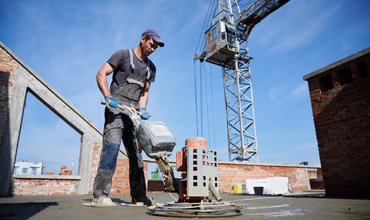
To prevent the surface mortar from setting too quickly, fresh ready mix concrete might be treated with a chemical retarder or "deactivator" placed on its surface. In contrast to concrete set retarders, they do not slow down the curing process and do not affect the concrete's strength development.
The brilliance of surface retarders is that they limit the hydration process to a precise depth, allowing the underlying concrete to harden appropriately and making removal of this surface paste simple.
A concrete retarder can be applied as soon as all finishing work is done and the bleed water has evaporated. Do not apply to cure compounds or sealers to the concrete before using a retarder.
Spread the surface retarder with a roller or low-pressure sprayer to cover the entire surface. A standard function of surface retarders is to generate a film over the surface, which shields the concrete from light wind and rain as it cures.
But if you predict a lot of wind or rain, cover the surface with plastic.
Based on their chemical composition, retardants can be classified as either.
• Organic Retarders
• Inorganic Retarders
• Strength
When retarding admixtures are added to ready mix concrete, the initial compressive strength of that concrete is lower than the initial compressive strength of a similar concrete that wasn't treated with retarding admixtures.
• Bleeding
Retarded concretes always have a higher chance of bleeding because retarding admixtures postpone the start of the setting process.
• Resilience
Retarded concrete should be just as durable as plain concrete if adequately cured.
• Slump Loss
It has been demonstrated that slump loss-retarding admixtures are highly effective at lowering slump loss and raising initial workability.
• Workability
Retarding admixtures barely affects how workable concrete is. They might increase the initial slump by 60 to 100 mm.
• The Heat of Hydration
While retarding admixtures do not decrease the heat output of concrete, they do postpone the peak temperature rise by a period corresponding to the duration of the concrete's retardation.
• Air Entrainment
Even while most retarding admixtures don't entrain air, there are some types of retarders that do. Particularly those based on hydroxycarboxylic acid reduce the amount of air in the atmosphere.
• Cycles of Freeze-Thaw
For ready mix concrete, air entraining admixtures are frequently used to increase freeze-thaw resistance. The air cells serve as tiny expansion chambers for the freezing water once the water in the concrete has begun to freeze.
• Volume Deformation
Retarding admixtures doesn't significantly impact creep and drying shrinkage, although they might marginally increase plastic shrinkage.
If you are looking for the perfect concrete supplier in London or a company that supports you with exclusive services and products for the construction business, in that case, we stand as the best-recommended name in the UK. From supplying superior quality ready mix concrete to offering you boom pumps, avail of everything within a budget price.